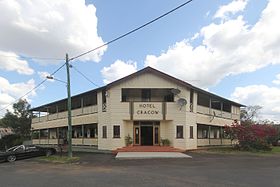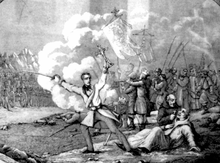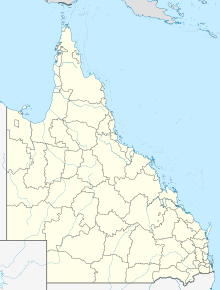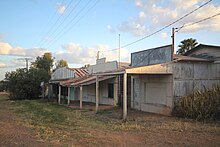Cracow
| Cracow | |||||||
|---|---|---|---|---|---|---|---|
 The Cracow Hotel at the main intersection |
|||||||
|
|||||||
|
|||||||
|
|||||||
|
|||||||
|
|
|||||||
Cracow is a place in the Australian state of Queensland . It is located 360 kilometers northwest of Brisbane in the Banana Shire . The place was founded in the 1930s during the last Australian gold rush and experienced very strong and rapid growth. However, the boom did not last, which is why more and more people left the city, which practically became a ghost town after the mine closed in 1976 . With the reopening of the mine in 2004, the place started to recover, so that today 89 people are living there again (as of 2016).
geography
location
Cracow is located in southwest Queensland, approx. 200 kilometers inland. Brisbane, the capital of the state, is 360 kilometers as the crow flies or 500 kilometers by road to the southeast. The closest places are Theodore (45 km north-west as the crow flies, 450 inhabitants), Taroom (60 km south-west, 585) and Eidsvold (80 km east, 650). Cracow is connected to this via the Eidsvold – Theodore Road, which has been completely asphalted since 2014, or the unpaved Cracow Road to Taroom, which meet in the center of the village. Cracow is located between the Burnett and Leichhardt Highways , which run through the places mentioned.
nature
Cracow is located on Boughyard Creek, which flows about three kilometers south into Cracow Creek, which drains into the Coral Sea via the Dawson River . In the vicinity of Cracow, at the confluence of Delusion Creek in the Dawson River, lies the so-called "Cracow Beach", a sandy stretch of shore surrounded by palm trees, which is popular with bathers and anglers.
To the east of Cracow, the Auburn Range extends up to 429 meters high.
Not far west of Cracow is the Precipice National Park .
climate
Cracow is located in the subtropical zone and is classified as Cfa according to Köppen and Geiger . Hot summers and mild winters are typical, although there can still be frost. Precipitation is concentrated in the summer months from November to March without being dry in winter. The following table shows climate statistics for the nearest weather station in Taroom, 60 kilometers away.
| Taroom | ||||||||||||||||||||||||||||||||||||||||||||||||
|---|---|---|---|---|---|---|---|---|---|---|---|---|---|---|---|---|---|---|---|---|---|---|---|---|---|---|---|---|---|---|---|---|---|---|---|---|---|---|---|---|---|---|---|---|---|---|---|---|
| Climate diagram | ||||||||||||||||||||||||||||||||||||||||||||||||
| ||||||||||||||||||||||||||||||||||||||||||||||||
|
Average monthly temperatures and rainfall for Taroom
Source: Australian Bureau of Meteorology : Taroom Post Office Station. Observation period: precipitation 1952–2016, temperatures 1952–2016. Retrieved April 4, 2016.
|
|||||||||||||||||||||||||||||||||||||||||||||||||||||||||||||||||||||||||||||||||||||||||||||||||||||||||
geology
In the rock around Cracow gold mineralization is found in steeply sloping, epithermal veins. These veins show up as individual veins that consist of quartz , carbonate and moonstone (adulara) in different percentages . Ten different deposits were found: Royal, Crown, Phoenix, Sovereign, Coronation, Empire, Roses Pride, Kilkenny, Tipperary and Klondyke North. The last three are currently being dismantled. They are between two and five meters thick.
history
Beginnings in sheep farming

The area around Cracow has traditionally been the country's Aborigine from the tribe of Wulli Wulli.
The German explorer Ludwig Leichhardt was the first European to travel to the area on his first expedition in 1844. Seven years later, John Mackenzie Ross, a white settler who kept 15,000 sheep on a farm, settled there. He named the place after the Polish city of Krakow , written Cracow in English , as it was a center of the Polish independence movement, which was in keeping with the liberal Australian spirit of the time - the nearby town of Eidsvold is also named after an important city of the liberal movement in Europe, namely Eidsvoll in Norway, named.
A drought set in in the 1860s and Ross gave up his farm after 20 years of farming. It was sold several times in the following decades due to persistent drought and low market prices, and belonged to the MacLeans, John Atherton and Bryan Palmes, among others, until it was finally acquired in 1903 by GK Jeffrey from New South Wales , whose family still owns it to this day.
First gold finds

GK Jeffrey had three ore prospectors search for gold in 1875 , but they soon turned to a more productive field near Eidsvold. Smaller amounts of gold were also found in the years 1850, 1903, 1913 and 1918 , but targeted mining did not start. An employee of the farm, the Aboriginal Johnny Nipps, had the greatest effect, who in 1913 while searching for a missing horse found a gold nugget just 10 kilometers north of the farmhouse, whereupon Charlie Lambert from Mount Isa inspected the area and found a reef that he called Warrego . But initially he did not pursue the findings any further.
Gold rush
This changed with the Great Depression of the 1930s: together with Billy Ryan and Billy Reynolds, Lambert returned to Cracow in 1931. They undertook further searches and finally registered their claim in February 1931. From the first 15 tons of ore , they extracted gold worth £ 4,000, so they named the field Surprise . They were soon so enthusiastic about their discovery that they were already speculating whether they might have discovered "a second Mount Morgan" - at the time one of the largest and most productive gold mines in the world.
On August 11, 1932, the Cracow Gold and Mineral Field was proclaimed. This attracted many prospectors: between June and December, 768 claims and 225 mining licenses were applied for, so that 3000 acres (over 1200 hectares) of land around Cracow were registered as mining areas by the end of the year. This enormous rush led to the fact that the city of Cracow was officially founded in 1932 and the first auction of town land took place on November 16, 1932 .
Cracow experienced tremendous and largely uncontrolled growth. All sorts of people in search of happiness came to the city; Tents, tin huts and other dwellings sprang up like mushrooms. In October 1932 there were already 1200 people living in the city and in November the number of inhabitants exceeded 2000. Because Cracow - not necessarily common for mining towns - could be reached by road, a relatively large number of women and children came to Cracow with the men. One housewife wrote about the place:
“Whether it is approached from Eidsvold, Theodore or Taroom, in each case one passes through" suburbs "of tents and a few shacks, set up in a haphazard manner amongst the trees. Next, the sight of sundry notices above the portals, such as "General Store", "Dawson Water", "Pioneer Butcher", indicates that "the town" is being approached. Before long one reaches the main street, easily distinguishable by the fact that here alone is any attempt made to keep buildings in line. "
“Regardless of whether you come from Eidsvold, Theodore or Taroom, in any case you drive through“ suburbs ”of tents and some huts that have been randomly set up between the trees. Next, various notes such as “General Store”, “Dawson Water” or “Pioneer Butcher” above the doors reveal that you are approaching “the city”. You will soon reach the main street, which can be easily recognized by the fact that some attempt is being made here alone to keep the buildings in a row. "
Many entrepreneurs soon seized the opportunity. There was a dance floor, an improvised movie theater and a few stealthy “grog shops” that illegally sold alcohol. The latter was halted when Alfred William Jarvis and his wife Agnes built the Cracow Hotel in 1936 .
At its peak, 3,000 residents were able to shop at seventeen shops, eight fruit sellers, five bakers, two butchers, two lemonade factories and two newsagents. There were twenty-four craftsmen, eight barbers, five plumbers, five auto repair shops, three tailors, three sawmills, three textile merchants, two blacksmiths, a brickworks and a stock trader. Several cafes, three billiard rooms, two picture shows, a dance hall, tennis courts and a soccer club provided entertainment. Noela Denmead wrote that "you can buy almost any product that can be found in a large city's department store."
In 1940 Cracow was the largest town in the Banana Shire. There was regular air traffic that brought news to the city, among other things - the road to Rockhampton took two days. After more than two years of planning and fundraising, a hospital was built for the supply in 1936, with a doctor, a dentist and two pharmacies on site. A police station was opened on February 9, 1933, and a school was set up on June 12 of the same year, which in 1934 had 120 children. Criminals convicted by the local police were first brought before the court of Theodore (1933-36) and later Eidsvold (1936), but from 1937 cases were decided in Cracow's own courthouse.
On September 30, 1932, a Chamber of Commerce was founded, which in the following years campaigned for many improvements in living conditions. In November 1933 a telephone connection to Cracow was laid, which could be used from November 23, 1933.
An increasing problem was the water supply, since with the Boughyard Creek only a permanent water source was available. The reservoir held by a dam dried up in 1931, which is why additional water had to be carted in from the Dawson River , which is more than 12 kilometers away . Then a nearly 550 meter long dam was built.
Golden plateau
Randolph Bedford was one of the first to step into Cracow. He founded Carpentaria Prospectors Ltd which secured the rights to Lambert's original discovery and adjacent areas. J. Berry built an ore crusher in 1932 with an output of 30 tons of ore per day. Australian Gold Mines Ltd sent their mining engineer Tom Victor to Cracow to take samples. These turned out to be so good that Victor called the area the "golden plateau", after which Australian Gold Mines founded the Golden Plateau NL Company .
Gradually this mine developed into the largest in the area. Other mines had to give up or could only survive through state subsidies for wages. However, Golden Plateau was producing 2,500 ounces of gold per month, which resulted in Cracow becoming a "One Mine Town". As early as 1935, Golden Plateau was producing gold worth £ 274,476, which was 97.3% of the total production in Cracow. By 1938, 121,347 troy ounces of gold were extracted from 179,551 tons of ore.
The adversity of World War II finally ensured that all other mines closed for good. But even Golden Plateau was not spared and had to reduce its production enormously:
| year | Gold production equivalent in £ |
|---|---|
| 1941 | 249,200 |
| 1942 | 164,844 |
| 1943 | 56,419 |
| 1945 | 38,550 |
These effects meant that Cracow's population was only 820 in 1940 and dropped to 420 by the end of World War II. After the end of the war, production was not restarted in the same style. A short interlude at the Klondyke mine ended in 1951. In the 1960s, Golden Plateau's production settled at around £ 220,000 a year, supported by around 80 employees. Cracow's population continued to drop to 300.
Closure of the mine

A combination of exhaustion of the ore deposits that could be mined economically, a low gold price on the world market and a necessary investment in a new ore mill led to the mine being closed in 1976.
With the mine also closed the police station (on October 31, 1976) and the hospital and many of the remaining residents left the place, which thus practically became a ghost town . The population sank to only 86. Many of the buildings that were once used were now vacant, left to their own devices and fell into disrepair. The only remaining company was the Cracow Hotel, which also acted as a shop, newsagent, post office and tourist information office.
In June 1979, Golden Plateau ceded its mining licenses, which were bought by Sedimentary Holdings Pty Ltd in July . Together with Costain Ltd , they reopened the mine on July 12, 1985 in order to use new technology to extract gold from the spoil heaps that had not yet been extracted. This provided work for 50 people and could produce 10 bars of gold per week. The success was not permanent, which is why this mine closed again in 1992.
At the end of 1997 the school in Cracow also closed.
Up to this point in time, a total of 850,000 troy ounces of gold had been mined in Cracow.
reopening
The company Newcrest Ltd took the mid-1990s to explore the resources back to where deeper in the soil and therefore not previously mined deposits were located. So promising was 10.1 grams of gold per tonne of ore with a prospect of yielding 790,000 troy ounces of gold that a joint venture of Sedimentary Holdings (30%) and Newcrest (70%) began reopening the mine. Development of the mine began in December 2003 and after investments of over 100 million Australian dollars , production began in November 2004.
Sedimentary Holdings' stake was later bought by Catalpa Resources Ltd , which merged with Conquest Mining Ltd in November 2011 . The newly formed company Evolution Mining Ltd acquired Newcrest's share in the Cracower joint venture and has been the sole owner and operator of the mine ever since.
| year | Gold production in troy ounces |
|---|---|
| 2010 | 102.760 |
| 2011 | 101,723 |
| 2012 | 102,565 |
| 2013 | 102,560 |
| 2014 | 95.064 |
| 2015 | 93.064 |
As a result of this new opening, the population rose again to 123 in 2006 and further to 196 in 2011. By 2016 it fell again to 89. However, the approximately 150 mine workers live in a specially built, non-permanent residential complex and are flown in and out on a weekly basis so that the population of the "actual" place is estimated to be less than 40.
With funds from the mine operator, the dilapidated courthouse was restored and converted into a Heritage Center, which opened on April 30, 2011. Evolution Mining is also involved in the construction of a tennis court, free camping sites and the financing of scholarships for the community.
Population development
The following table shows the population of Cracow in various official censuses.
| census | Residents |
|---|---|
| 1933 | 858 |
| 1947 | 417 |
| 1954 | 367 |
| 1961 | 411 |
| 1966 | 284 |
| 1971 | 302 |
| 2006 | 123 |
| 2011 | 196 |
| 2016 | 89 |
Attractions
The many old, partly dilapidated buildings offer an interesting ghost town atmosphere. The building of the RSL Club, which is one of the few still preserved, as well as the building of the former Bank of New South Wales , which is right next to the pub, deserve special mention .
The Heritage Center in the restored courthouse gives a detailed insight into the eventful history of the city and provides information about the local gold deposits and how mining works. Tours of the mine are not offered.
The Cracow Hotel is the only shop left. The two-story building is built in the typical Queenslander style: it is almost entirely made of wood and does not stand directly on the ground, but rests on many piles. This allows better cooling in hot summer through drafts and keeps unpleasant animals away. Also typical is the large and wide verandah, which was built around three quarters of the building on both floors and serves as additional seating and living space. In the back, an outside staircase leads to the inner courtyard of the corner building, which is used as the main staircase due to the mostly sunny weather.
The building houses a classic outback pub on the ground floor, which attracts many tourists - not only because they want to have a drink after exploring the ghost town, but especially because of the many strange objects that adorn the walls and ceilings, which make the pub so special Give appearance. There are ten unusually furnished hotel rooms on the upper floor.
The hotel is owned by Fred Brophy, who runs Australia's last remaining boxing tent with Fred Brophy's Boxing Troupe . From this "base" he travels with his tent to public festivals all over Queensland, where volunteers from the audience compete in boxing matches against his troops. Once a year, the Boxing Tent also visits Cracow, which is the biggest event of the year for Cracow: several hundred guests regularly come to see the show.
In the immediate vicinity of the city there is also the swimming and fishing spot Cracow Beach on the Dawson River and the Precipice National Park , which attract nature lovers.
gallery
Web links
- Virtual city tour through the ghost town via Google Street View
- Detailed information on the mine from Evolution Mining Ltd
Individual evidence
- ↑ a b c Bonzle: Map of Cracow, QLD . Retrieved April 4, 2016.
- ↑ a b c d Australian Bureau of Statistics : Cracow ( English ) In: 2016 Census QuickStats . June 27, 2017. Retrieved April 13, 2020.
- ↑ Queensland Government: Eidsvold-Theodore Road sealing ( Memento of the original from April 5, 2016 in the Internet Archive ) Info: The archive link was inserted automatically and has not yet been checked. Please check the original and archive link according to the instructions and then remove this notice. . Retrieved April 5, 2016.
- ↑ a b c d e f Banana Shire : Welcome to Cracow ( Memento of the original from March 10, 2016 in the Internet Archive ) Info: The archive link was inserted automatically and has not yet been checked. Please check the original and archive link according to the instructions and then remove this notice. . Retrieved April 4, 2016.
- ↑ Bonzle: Map of Auburn Range, QLD . Retrieved April 4, 2016.
- ↑ Heavy frost has been experienced . In: Morning Bulletin , July 13, 1953, p. 7. Retrieved April 6, 2016.
- ↑ For a map of some of the soil occurrences, see page 21 of this Evolution Mining presentation .
- ↑ Evolution Mining: Cracow Fact Sheet (PDF). Retrieved April 4, 2016.
- ↑ Inga Stünzner: Theodore, Cracow's native title claims . August 13, 2015. Retrieved April 4, 2016
- ^ Queensland Government place names search: Cracow (City Town Township) . Retrieved April 4, 2016.
- ^ Nomenclature of Queensland - Cracow . In: The Courier-Mail of January 24, 1936 ( online ). "Compiled from records in The Oxley Memorial Library". Retrieved April 4, 2016.
- ^ A b c John Darbyshire, Charles Edward Sayers: Old Gold Towns of Queensland . Rigby, Adelaide, 1973. ISBN 9780851796048 . Quoted from an online excerpt ( memento from October 23, 2009 in the Internet Archive )
- ^ The Cracow Field - Gold Field Proclaimed - Town Site and Roads . In: The Telegraph , August 10, 1932, p. 9. Retrieved April 6, 2016.
- ^ Cracow Gold Field . In: Northern Star , Aug 11, 1932, p. 7. Retrieved April 6, 2016.
- ↑ Information boards in the Heritage Center in Cracow.
- ↑ a b c QueenslandPlaces.com.au: Cracow . Retrieved April 4, 2016.
- ^ Quoted from a "contemporary brochure" according to queenslandplaces.com.au . The list can also be found in Welcome to Cracow and on the information boards of the Heritage Center.
- ↑ Cracow expects shortly to have its own hospital . In: The Courier-Mail , December 27, 1933, p. 13. Retrieved April 6, 2016.
- ^ A b News and notes from country - Cracow . In: Morning Bulletin , October 6, 1932, p. 11. Retrieved April 6, 2016.
- ↑ a b Queensland Government: Agency ID2014, Police Station, Cracow . In: Queensland State Archives. Retrieved April 5, 2016.
- ^ A b Queensland Government: Agency ID5139, Cracow State School . In: Queensland State Archives. Retrieved April 5, 2016.
- ^ Country News - Cracow . In: The Courier-Mail , June 5, 1934, p. 4. Retrieved April 6, 2016.
- ↑ Queensland Government: Agency ID638, Police Charge Bench Books . In: Queensland State Archives. Retrieved April 5, 2016.
- ^ Telephone for Cracow . In: The Courier-Mail , November 24, 1933, p. 17. Retrieved April 6, 2016.
- ^ Cracow Gold Field: Progress and difficulties . In: The Brisbane Courier , August 25, 1932, p. 20. Retrieved April 6, 2016.
- ↑ Dam drying up . In: The Brisbane Courier , August 19, 1932, p. 14. Retrieved April 6, 2016.
- ↑ a b c Tim Lee: Old gold town revels in resources boom . In: ABC Landline of February 23, 2006. Retrieved December 28, 2018.
- ↑ a b c d e Evolution Mining: Our Assets - Cracow . Retrieved April 4, 2016.
- ↑ Angela Kean: Catalpa Resources and Conquest Mining unite to form top five Australian gold producers . October 14, 2011. Retrieved April 4, 2016.
- ^ Newcrest Ltd : About us - History . Retrieved April 4, 2016.
- ^ A b Australian Bureau of Statistics : Cracow (Banana Shire) State Suburb ( English ) In: 2006 Census QuickStats . October 25, 2007. Retrieved April 4, 2016.
- ↑ a b Australian Bureau of Statistics : Cracow State Suburb ( English ) In: 2006 Census QuickStats . October 25, 2007. Retrieved April 4, 2016.
- ↑ Commonwealth Bureau of Census and Statistics: Census of the Commonwealth of Australia, June 30th, 1947. Part VIII. - Population and occupied dwellings in localities , page 510 (page 18 in PDF). Retrieved April 4, 2016.
- ↑ Commonwealth Bureau of Census and Statistics: Census of the Commonwealth of Australia, June 30th, 1961. Volume III. - Queensland. Part V. - Population and dwellings in localities , page 14. Retrieved April 4, 2016.
- ↑ Commonwealth Bureau of Census and Statistics: Census of Population and Housing, June 30, 1966, Volume 5: Population and Dwellings in Localities, Part 3: Queensland , p. 8. Retrieved April 4, 2016.













